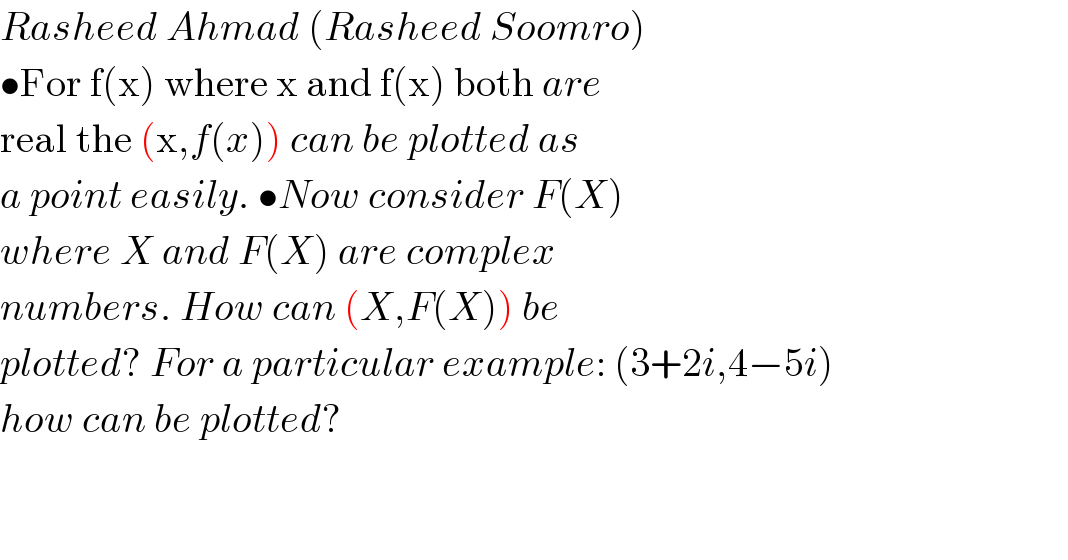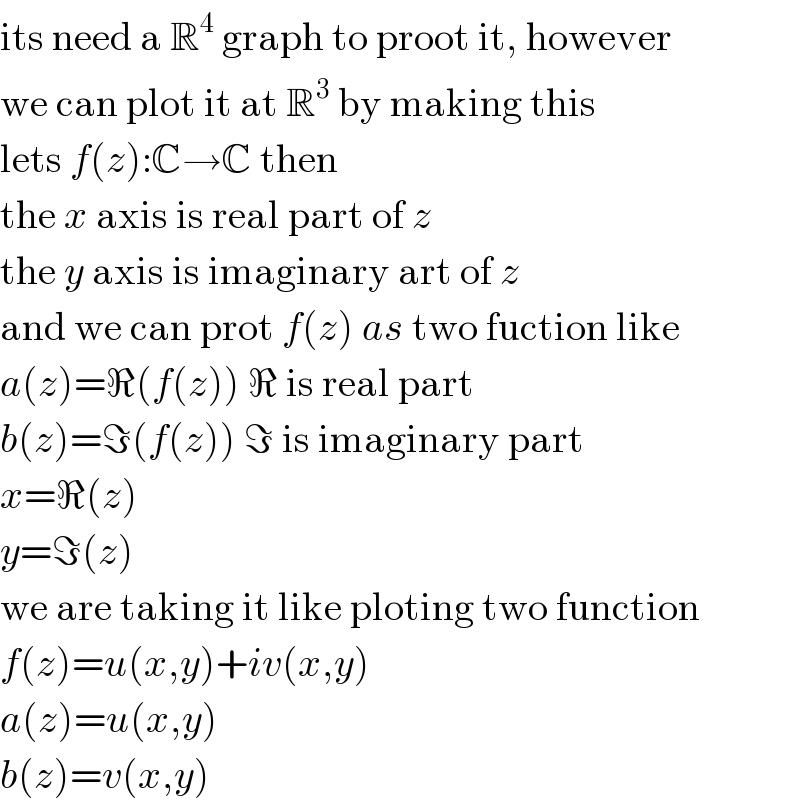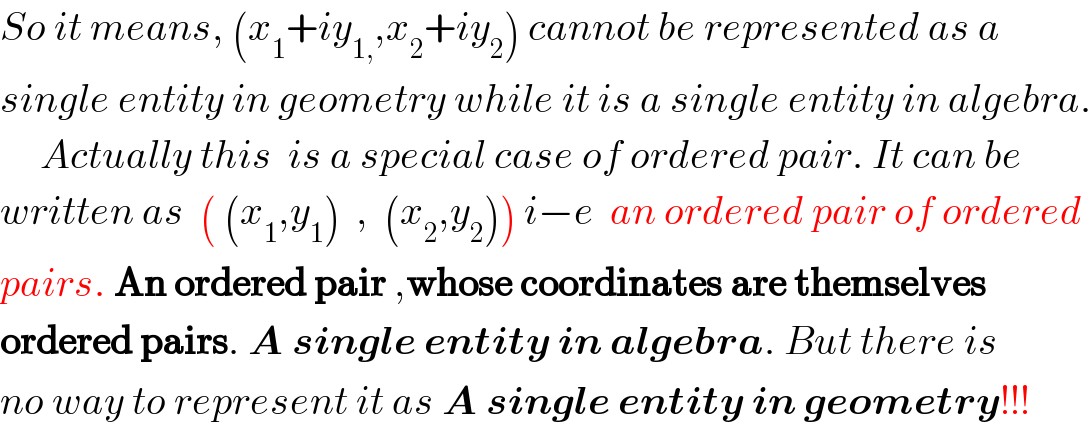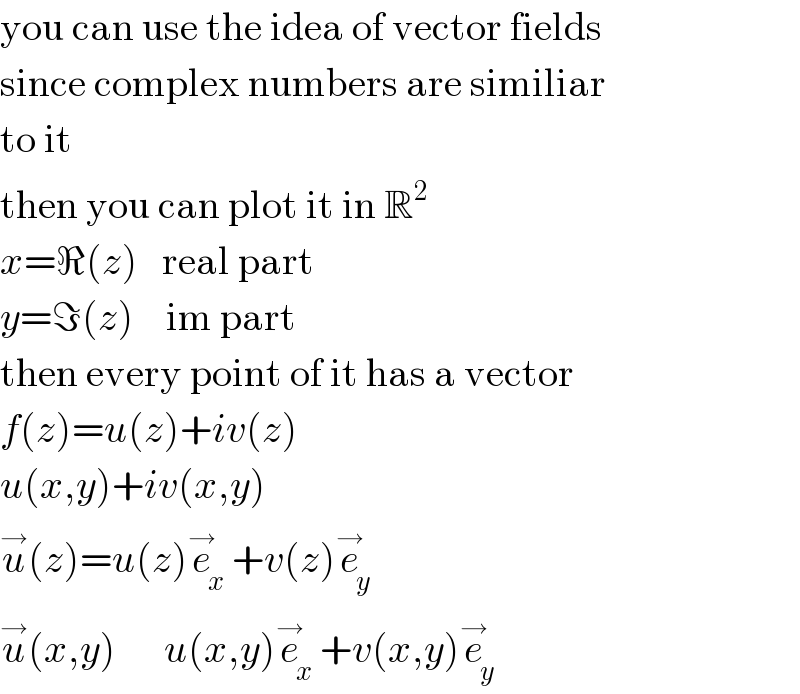
Question Number 1239 by Rasheed Ahmad last updated on 17/Jul/15

$${Rasheed}\:{Ahmad}\:\left({Rasheed}\:{Soomro}\right) \\ $$$$\bullet\mathrm{For}\:\mathrm{f}\left(\mathrm{x}\right)\:\mathrm{where}\:\mathrm{x}\:\mathrm{and}\:\mathrm{f}\left(\mathrm{x}\right)\:\mathrm{both}\:{are} \\ $$$$\mathrm{real}\:\mathrm{the}\:\left(\mathrm{x},{f}\left({x}\right)\right)\:{can}\:{be}\:{plotted}\:{as} \\ $$$${a}\:{point}\:{easily}.\:\bullet{Now}\:{consider}\:{F}\left({X}\right) \\ $$$${where}\:{X}\:{and}\:{F}\left({X}\right)\:{are}\:{complex}\: \\ $$$${numbers}.\:{How}\:{can}\:\left({X},{F}\left({X}\right)\right)\:{be} \\ $$$${plotted}?\:{For}\:{a}\:{particular}\:{example}:\:\left(\mathrm{3}+\mathrm{2}{i},\mathrm{4}−\mathrm{5}{i}\right) \\ $$$${how}\:{can}\:{be}\:{plotted}? \\ $$$$ \\ $$$$ \\ $$
Commented by 123456 last updated on 18/Jul/15

$$\mathrm{its}\:\mathrm{need}\:\mathrm{a}\:\mathbb{R}^{\mathrm{4}} \:\mathrm{graph}\:\mathrm{to}\:\mathrm{proot}\:\mathrm{it},\:\mathrm{however} \\ $$$$\mathrm{we}\:\mathrm{can}\:\mathrm{plot}\:\mathrm{it}\:\mathrm{at}\:\mathbb{R}^{\mathrm{3}} \:\mathrm{by}\:\mathrm{making}\:\mathrm{this} \\ $$$$\mathrm{lets}\:{f}\left({z}\right):\mathbb{C}\rightarrow\mathbb{C}\:\mathrm{then} \\ $$$$\mathrm{the}\:{x}\:\mathrm{axis}\:\mathrm{is}\:\mathrm{real}\:\mathrm{part}\:\mathrm{of}\:{z} \\ $$$$\mathrm{the}\:{y}\:\mathrm{axis}\:\mathrm{is}\:\mathrm{imaginary}\:\mathrm{art}\:\mathrm{of}\:{z} \\ $$$$\mathrm{and}\:\mathrm{we}\:\mathrm{can}\:\mathrm{prot}\:{f}\left({z}\right)\:{as}\:\mathrm{two}\:\mathrm{fuction}\:\mathrm{like} \\ $$$${a}\left({z}\right)=\Re\left({f}\left({z}\right)\right)\:\Re\:\mathrm{is}\:\mathrm{real}\:\mathrm{part} \\ $$$${b}\left({z}\right)=\Im\left({f}\left({z}\right)\right)\:\Im\:\mathrm{is}\:\mathrm{imaginary}\:\mathrm{part} \\ $$$${x}=\Re\left({z}\right) \\ $$$${y}=\Im\left({z}\right) \\ $$$$\mathrm{we}\:\mathrm{are}\:\mathrm{taking}\:\mathrm{it}\:\mathrm{like}\:\mathrm{ploting}\:\mathrm{two}\:\mathrm{function} \\ $$$${f}\left({z}\right)={u}\left({x},{y}\right)+{iv}\left({x},{y}\right) \\ $$$${a}\left({z}\right)={u}\left({x},{y}\right) \\ $$$${b}\left({z}\right)={v}\left({x},{y}\right) \\ $$
Commented by Rasheed Soomro last updated on 18/Jul/15

$${So}\:{it}\:{means},\:\left({x}_{\mathrm{1}} +{iy}_{\mathrm{1},} ,{x}_{\mathrm{2}} +{iy}_{\mathrm{2}} \right)\:{cannot}\:{be}\:{represented}\:{as}\:{a} \\ $$$${single}\:{entity}\:{in}\:{geometry}\:{while}\:{it}\:{is}\:{a}\:{single}\:{entity}\:{in}\:{algebra}. \\ $$$$\:\:\:\:\:{Actually}\:{this}\:\:{is}\:{a}\:{special}\:{case}\:{of}\:{ordered}\:{pair}.\:{It}\:{can}\:{be}\: \\ $$$${written}\:{as}\:\:\left(\:\left({x}_{\mathrm{1}} ,{y}_{\mathrm{1}} \right)\:\:,\:\:\left({x}_{\mathrm{2}} ,{y}_{\mathrm{2}} \right)\right)\:{i}−{e}\:\:{an}\:{ordered}\:{pair}\:{of}\:{ordered} \\ $$$${pairs}.\:\boldsymbol{\mathrm{An}}\:\boldsymbol{\mathrm{ordered}}\:\boldsymbol{\mathrm{pair}}\:,\boldsymbol{\mathrm{whose}}\:\boldsymbol{\mathrm{coordinates}}\:\boldsymbol{\mathrm{are}}\:\boldsymbol{\mathrm{themselves}}\: \\ $$$$\boldsymbol{\mathrm{ordered}}\:\boldsymbol{\mathrm{pairs}}.\:\boldsymbol{{A}}\:\boldsymbol{{single}}\:\boldsymbol{{entity}}\:\boldsymbol{{in}}\:\boldsymbol{{algebra}}.\:{But}\:{there}\:{is} \\ $$$${no}\:{way}\:{to}\:{represent}\:{it}\:{as}\:\boldsymbol{{A}}\:\boldsymbol{{single}}\:\boldsymbol{{entity}}\:\boldsymbol{{in}}\:\boldsymbol{{geometry}}!!! \\ $$
Commented by 123456 last updated on 18/Jul/15

$$\mathrm{you}\:\mathrm{can}\:\mathrm{use}\:\mathrm{the}\:\mathrm{idea}\:\mathrm{of}\:\mathrm{vector}\:\mathrm{fields} \\ $$$$\mathrm{since}\:\mathrm{complex}\:\mathrm{numbers}\:\mathrm{are}\:\mathrm{similiar} \\ $$$$\mathrm{to}\:\mathrm{it} \\ $$$$\mathrm{then}\:\mathrm{you}\:\mathrm{can}\:\mathrm{plot}\:\mathrm{it}\:\mathrm{in}\:\mathbb{R}^{\mathrm{2}} \\ $$$${x}=\Re\left({z}\right)\:\:\:\mathrm{real}\:\mathrm{part} \\ $$$${y}=\Im\left({z}\right)\:\:\:\:\mathrm{im}\:\mathrm{part} \\ $$$$\mathrm{then}\:\mathrm{every}\:\mathrm{point}\:\mathrm{of}\:\mathrm{it}\:\mathrm{has}\:\mathrm{a}\:\mathrm{vector} \\ $$$${f}\left({z}\right)={u}\left({z}\right)+{iv}\left({z}\right) \\ $$$${u}\left({x},{y}\right)+{iv}\left({x},{y}\right) \\ $$$$\overset{\rightarrow} {{u}}\left({z}\right)={u}\left({z}\right)\overset{\rightarrow} {{e}}_{{x}} +{v}\left({z}\right)\overset{\rightarrow} {{e}}_{{y}} \\ $$$$\overset{\rightarrow} {{u}}\left({x},{y}\right)\:\:\:\:\:\:{u}\left({x},{y}\right)\overset{\rightarrow} {{e}}_{{x}} +{v}\left({x},{y}\right)\overset{\rightarrow} {{e}}_{{y}} \\ $$
Commented by Rasheed Soomro last updated on 18/Jul/15

$$\:\:\:\:\:\:\:\:\:\:{Thanks}\:{Sir}\:\left(\mathrm{123456}\right)\:\:\:\:\: \\ $$
